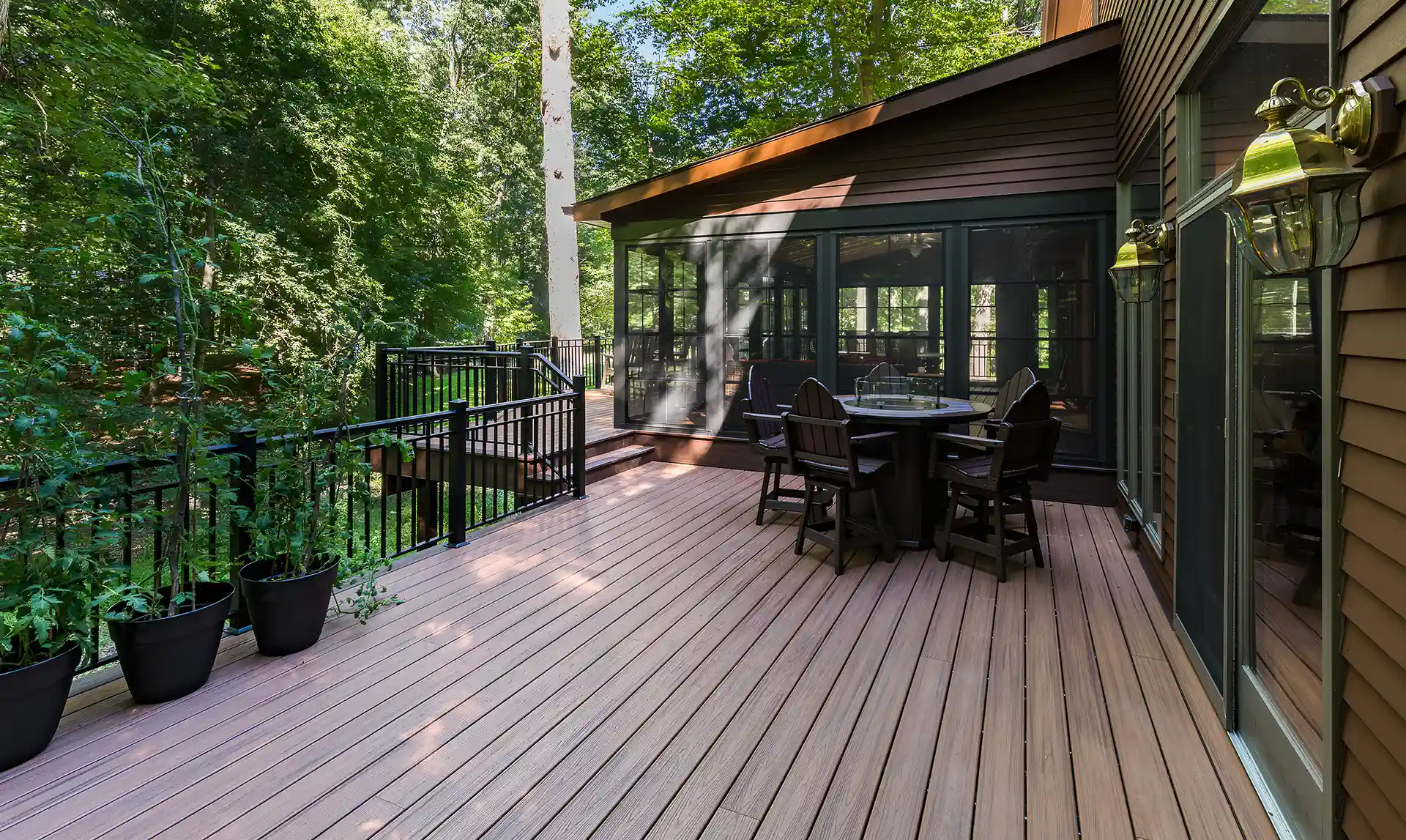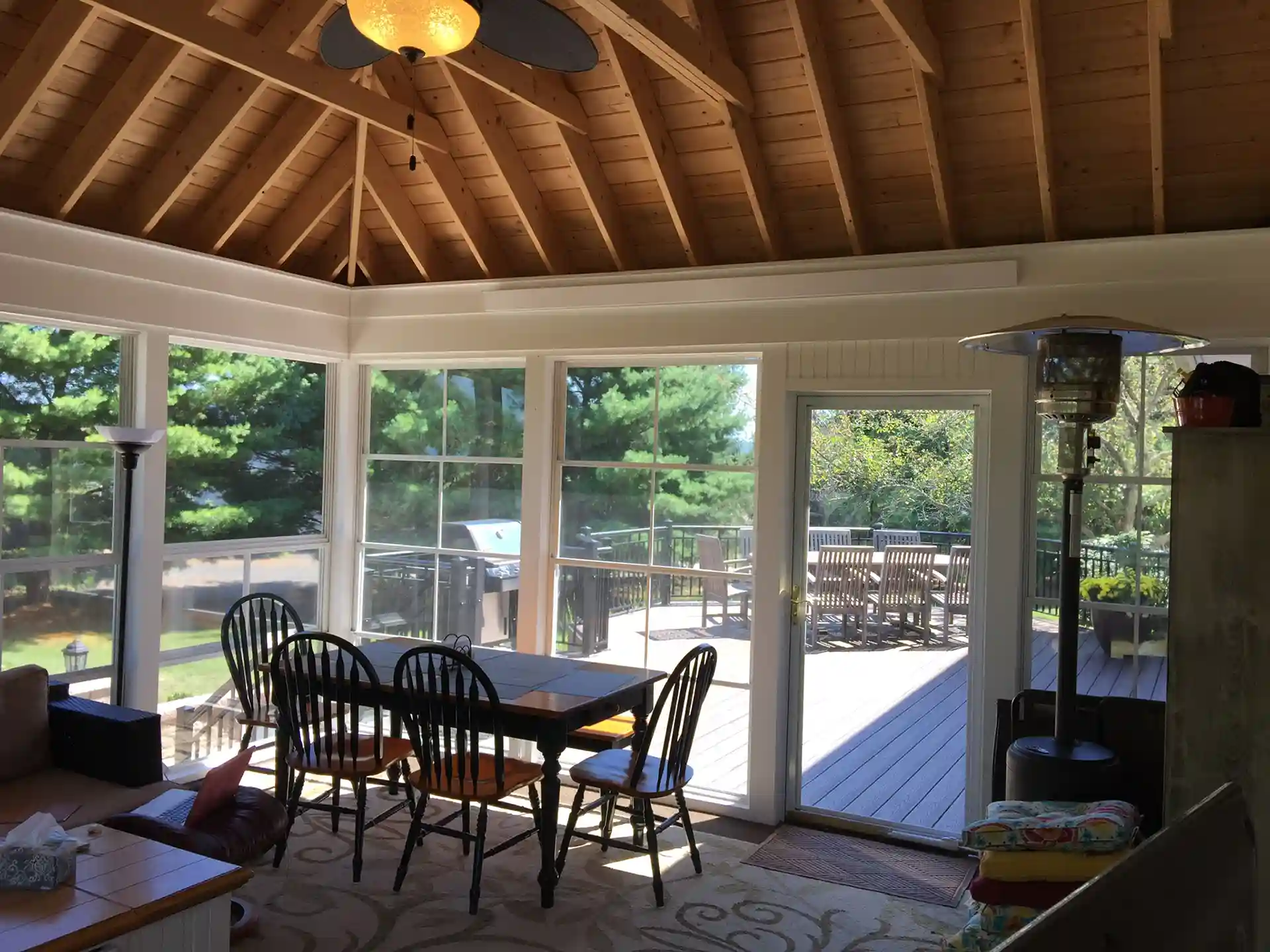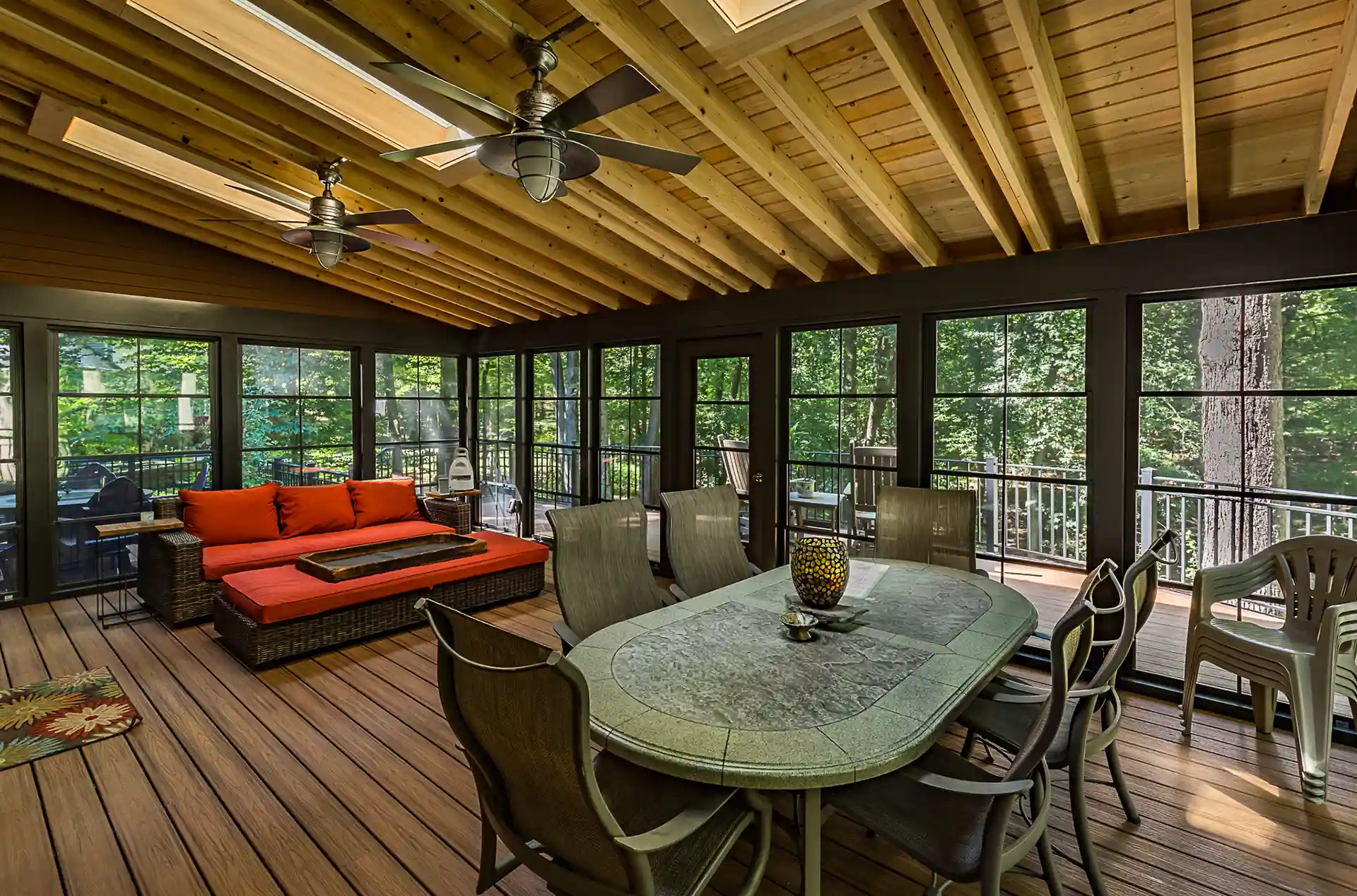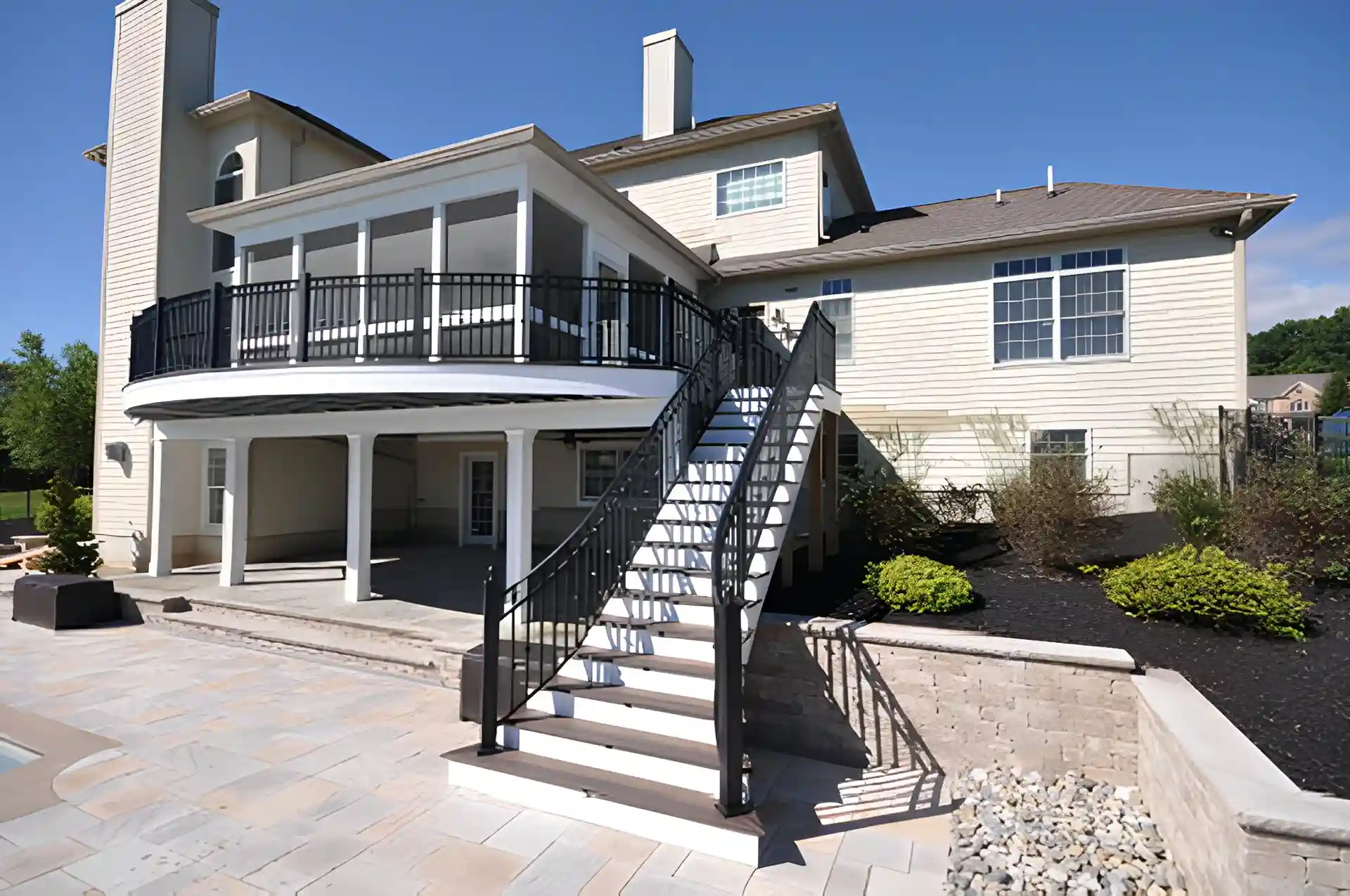Read this if you’re short on time.
A 3-season room offers enclosed space for spring, summer, and fall use with basic protection from elements, while a 4-season room provides year-round comfort through better insulation and heating options. The main difference between a 3-season room and a 4-season room lies in thermal performance and construction for all-weather durability. Homeowners often choose based on climate needs and budget priorities. At My Deck, we build both types as reliable home extensions in New Jersey and Pennsylvania to solve your space challenges effectively.
Homeowners often question the difference between a 3-season room and a 4-season room when planning a sunroom addition. These structures expand living areas while connecting indoor comfort to outdoor views. A 3-season room is ideal for milder weather, but a 4-season room handles all conditions as a true home extension. We address common concerns like construction variances and long-term value. Understanding these options helps you select the right fit for your property. My Deck provides clear guidance to make your decision straightforward.
What is a 3-Season Room?
A 3-season room serves as an enclosed space that bridges indoor living with outdoor elements during milder months. This type of sunroom focuses on protecting against rain, wind, and insects without full climate control. We see many homeowners opt for this when they want a cost-effective way to extend their usable space seasonally.
These rooms typically feature lightweight aluminum frames and single-pane glass or screens that allow airflow in warmer weather. Windows can open or switch to screens for ventilation. Foundations often build on existing patios or decks, keeping construction simpler. For example, in regions with moderate winters, this setup lets families enjoy barbecues or reading sessions without direct exposure to bugs or light rain.
Upgrades like double-pane glass can improve basic comfort, but the design prioritizes three-season use. Homeowners in New Jersey and Pennsylvania find this practical for spring gatherings or fall relaxation. The difference between a 3-season room and a 4-season room starts here, with the former lacking thermal engineering for cold months.
What is a 4-Season Room?
A 4-season room acts as a fully integrated home addition designed for comfort in any weather. This sunroom type emphasizes durability and temperature regulation to function like an extra living room year-round. We recommend it for those seeking consistent access to natural light without seasonal limitations.
Construction includes thermally engineered frames, double-pane insulated glass, and connections to the home’s HVAC system. Walls and ceilings are properly insulated to maintain indoor temperatures. For instance, families can host winter holidays or summer parties in the same space without discomfort from heat or cold.
This setup allows for features like vaulted ceilings or skylights, enhancing the room’s appeal as a versatile area. In areas with harsh winters like Pennsylvania, it provides a reliable retreat. The difference between a 3-season room and a 4-season room becomes clear in its ability to serve as a permanent extension rather than a temporary enclosure.
Structural Differences and Construction Materials
Structural variances define how these rooms perform over time and integrate with your home. A 3-season room uses simpler builds for quick installation, while a 4-season room requires robust materials for longevity. We evaluate these based on your property’s foundation and existing structure to ensure stability.
For a 3-season room, frames often consist of extruded aluminum resistant to fading and scratching. Glass panels are single-pane, with options for upgrades, and the build may use an existing deck as a base. This keeps the structure lightweight and focused on basic enclosure. An example is enclosing a porch with screens and windows for a transitional space that feels open yet protected.
In contrast, a 4-season room employs thermally engineered aluminum or similar materials that support heating and cooling. Double-pane glass comes standard, and the foundation matches home building codes for load-bearing. This allows for additions like siding that blends with your house exterior. Homeowners notice the difference between a 3-season room and a 4-season room in how the latter feels like a seamless part of the residence.
Installation time varies, with 3-season rooms completing faster due to fewer requirements. 4-season rooms involve more planning for footers and integration. Both can customize to fit your layout, but the 4-season option demands precise engineering for safety.
Insulation and Climate Control
Insulation and climate features determine usability across temperatures. A 3-season room provides minimal barriers against extremes, suitable for temperate periods. A 4-season room prioritizes energy efficiency through advanced materials. We assess your local weather patterns to recommend the best approach for comfort.
3-season rooms often lack wall insulation, relying on single-pane glass that doesn’t retain heat well. Temporary solutions like space heaters or fans offer limited relief on cooler days. For example, during a mild Pennsylvania autumn, this setup keeps the space usable without full HVAC ties.
4-season rooms include insulated walls, ceilings, and double-pane glass to minimize heat loss. They connect directly to your home’s heating and cooling system for consistent control. This makes them ideal for New Jersey winters, where temperatures drop significantly. The difference between a 3-season room and a 4-season room shines in energy savings from proper sealing.
Both types can add tints to glass for UV protection, reducing solar gain. However, only the 4-season design ensures year-round temperature stability without drafts.
Cost Comparison
Cost factors influence decisions when adding a sunroom to your property. 3-season rooms generally require less investment due to simpler designs. 4-season rooms involve higher upfront expenses for enhanced features. We help homeowners weigh these against long-term benefits like usage frequency.
Materials and labor for a 3-season room cost less due to lightweight components and quicker construction. No need for extensive insulation or HVAC integration keeps expenses down. For instance, using an existing foundation avoids additional site work, making it accessible for budget-conscious projects.
4-season rooms cost more from engineered frames, insulated elements, and full system connections. The added durability justifies the cost for those planning frequent use. Financing options can ease the burden for either type. Ultimately, your choice depends on how the room fits your lifestyle and home improvement goals.
Climate and Seasonal Suitability
Local weather dictates which room type performs best for your needs. 3-season rooms excel in milder conditions, offering protection without over-engineering. 4-season rooms handle extremes, providing flexibility in variable climates. We consider New Jersey and Pennsylvania’s seasons—mild springs to harsh winters—when advising clients.
A 3-season room suits spring through fall, blocking rain and wind while allowing breezes. It’s less effective in winter due to poor heat retention, limiting its use in colder months. Homeowners in moderate areas enjoy it for outdoor dining or relaxation without full enclosure costs.
A 4-season room thrives in all conditions, with insulation shielding against snow or heat waves. This ensures comfort during Pennsylvania blizzards or New Jersey summers. Both enhance natural light exposure, but the 4-season option extends this benefit year-round.
Maintenance & Longevity
Maintenance routines and expected lifespan affect ownership experience. 3-season rooms demand basic upkeep due to exposed elements. 4-season rooms require similar care but benefit from protective features. We stress regular inspections to maximize durability for both.
For 3-season rooms, cleaning glass and frames prevents buildup from seasonal debris. Aluminum resists corrosion, but screens may need to be replaced over time. In humid New Jersey summers, checking for mold is essential to longevity. These rooms last well with minimal intervention if built to code.
4-season rooms involve maintaining HVAC connections and insulated seals to avoid efficiency loss. Durable materials like double-pane glass reduce wear from temperature swings. Pennsylvania’s freeze-thaw cycles test structures, but properly constructed structures hold up. The difference between a 3-season room and a 4-season room includes the latter’s resilience in demanding environments.
Both types meet building standards for safety, with warranties covering frames. Consistent care extends their service life significantly.
Impact on Property Value
Adding either room can boost your home’s appeal and market value. 3-season rooms provide affordable enhancements that attract buyers seeking outdoor ties. 4-season rooms add livable square footage, increasing assessed value. We guide clients on how these influence resale in New Jersey and Pennsylvania markets.
A 3-season room offers transitional space that enhances curb appeal. It appeals to families wanting seasonal entertainment areas. For example, it can differentiate your property from competitors’ listings by offering protected views.
A 4-season room counts as a permanent living area, potentially raising property taxes but yielding higher returns. Buyers value the versatility for offices or playrooms. Local real estate trends favor additions that blend with the home, maximizing investment recovery.
Customization Options
Customization lets you tailor the room to your preferences and home style. 3-season rooms allow basic modifications for function. 4-season rooms support advanced designs for integration. We work with homeowners to incorporate features that solve specific space issues.
In 3-season rooms, options include screen types, glass upgrades, and frame colors. You can add electrical outlets for lighting or fans. This flexibility suits simple layouts, like enclosing a patio for bug-free evenings.
4-season rooms offer more, such as window configurations, ceiling styles, or door systems for flow. Skylights or beadboard add character. In Pennsylvania homes, matching siding ensures cohesion. The difference between a 3-season room and a 4-season room lies in the scope of personalization for daily use.
Both can fit unique lots, but planning addresses zoning and permits early.
Year-Round Usage
Usage patterns highlight the practical benefits of each design. 3-season rooms limit enjoyment to favorable weather. 4-season rooms enable constant access regardless of the season. We help determine your needs based on family activities and climate.
A 3-season room shines for summer barbecues or fall reading, providing shelter without heating. It’s ideal for allergy sufferers who can keep windows closed in pollen seasons. However, winter restricts it to storage or minimal use.
A 4-season room supports holidays, workouts, or relaxation anytime. HVAC integration maintains comfort, allowing furniture placement like in the main living areas. New Jersey’s variable weather makes this invaluable. Planning utilities ensures a seamless integration into daily life.
Which Should You Choose for Your Home?
Selecting between these options depends on your priorities and environment. Consider usage frequency, budget, and weather tolerance when deciding. We outline a clear path to match the room to your goals without complications.
If seasonal enjoyment suffices, a 3-season room provides value through simplicity. It fits homes in milder parts of Pennsylvania where winters are short. Families appreciate the lower entry point for expanding space.
For full-year benefits, a 4-season room delivers as a reliable addition. It suits New Jersey properties with longer cold spells, offering return on versatility.
Evaluate site conditions and consult experts to avoid common pitfalls.
Finding the best Season Rooms Contractors in NJ and PA
At My Deck, we stand out as the go-to contractor for 3-season rooms and 4-season rooms in New Jersey and Pennsylvania through our commitment to quality builds. Our team brings decades of experience in creating sunrooms that integrate flawlessly with existing homes. We focus on using durable materials that meet local codes, ensuring every project withstands regional weather.
What sets My Deck apart is our tailored approach that addresses each client’s unique needs without overcomplicating the process. Our track record includes countless satisfied customers who enjoy their home extensions year after year. In competitive markets like New Jersey and Pennsylvania, we provide the expertise to make your sunroom a worthwhile investment.
Ready to Build Your Ideal Season Room?
Take the next step toward enhancing your home with a 3-season room or 4-season room that fits your needs. Schedule a consultation with My Deck to discuss the difference between 3-season room and 4-season room options. Our team in New Jersey and Pennsylvania makes the process simple and effective. Contact us today for personalized guidance.
3-Season Room vs 4-Season Room FAQs
Can a 3-season room be converted into a 4-season room?
Yes, conversion is possible by adding insulation, upgrading windows, and integrating HVAC systems. This upgrades the sunroom for year-round use but requires structural assessments. We evaluate your existing three-season porch to ensure a smooth transition.
Which is more energy-efficient?
A 4-season room is more energy-efficient due to its insulated walls and double-pane glass. It reduces heating costs compared to a 3-season room. Homeowners notice savings in New Jersey and Pennsylvania climates.
Are permits required for both types of rooms?
Permits are typically required for both 3-season rooms and 4-season rooms to meet building codes. Local regulations in New Jersey and Pennsylvania vary by municipality. We handle the permitting process to avoid delays.
How long does construction take?
Construction of a 3-season room can take a few days to a few weeks, depending on the size. A 4-season room takes longer due to foundation and insulation work. Factors like weather influence timelines in our service areas.
Which season room is better for resale value?
A 4-season room generally boosts resale value more by adding livable square footage. It appeals to buyers seeking four-season additions. The difference between a 3-season room and a 4-season room positively affects market perception.
What is the main difference between a 3-season and a 4-season room?
The main difference lies in thermal performance and year-round usability. A 3-season room suits milder seasons without full insulation. A 4-season room functions as a home extension with climate control.




